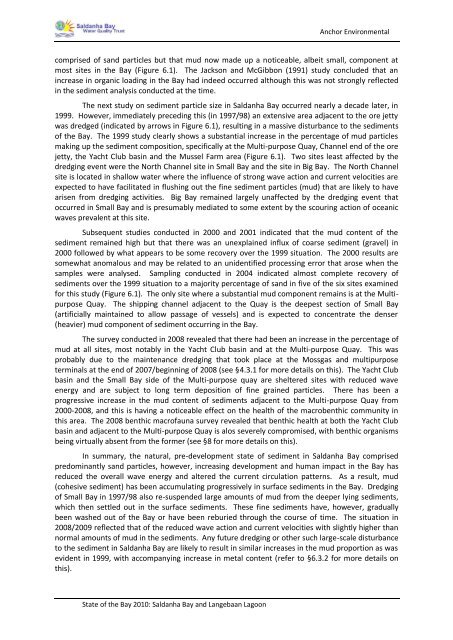State of the Bay Report 2010-Final - Anchor Environmental
State of the Bay Report 2010-Final - Anchor Environmental
State of the Bay Report 2010-Final - Anchor Environmental
You also want an ePaper? Increase the reach of your titles
YUMPU automatically turns print PDFs into web optimized ePapers that Google loves.
<strong>State</strong> <strong>of</strong> <strong>the</strong> <strong>Bay</strong> <strong>2010</strong>: Saldanha <strong>Bay</strong> and Langebaan Lagoon<br />
<strong>Anchor</strong> <strong>Environmental</strong><br />
comprised <strong>of</strong> sand particles but that mud now made up a noticeable, albeit small, component at<br />
most sites in <strong>the</strong> <strong>Bay</strong> (Figure 6.1). The Jackson and McGibbon (1991) study concluded that an<br />
increase in organic loading in <strong>the</strong> <strong>Bay</strong> had indeed occurred although this was not strongly reflected<br />
in <strong>the</strong> sediment analysis conducted at <strong>the</strong> time.<br />
The next study on sediment particle size in Saldanha <strong>Bay</strong> occurred nearly a decade later, in<br />
1999. However, immediately preceding this (in 1997/98) an extensive area adjacent to <strong>the</strong> ore jetty<br />
was dredged (indicated by arrows in Figure 6.1), resulting in a massive disturbance to <strong>the</strong> sediments<br />
<strong>of</strong> <strong>the</strong> <strong>Bay</strong>. The 1999 study clearly shows a substantial increase in <strong>the</strong> percentage <strong>of</strong> mud particles<br />
making up <strong>the</strong> sediment composition, specifically at <strong>the</strong> Multi-purpose Quay, Channel end <strong>of</strong> <strong>the</strong> ore<br />
jetty, <strong>the</strong> Yacht Club basin and <strong>the</strong> Mussel Farm area (Figure 6.1). Two sites least affected by <strong>the</strong><br />
dredging event were <strong>the</strong> North Channel site in Small <strong>Bay</strong> and <strong>the</strong> site in Big <strong>Bay</strong>. The North Channel<br />
site is located in shallow water where <strong>the</strong> influence <strong>of</strong> strong wave action and current velocities are<br />
expected to have facilitated in flushing out <strong>the</strong> fine sediment particles (mud) that are likely to have<br />
arisen from dredging activities. Big <strong>Bay</strong> remained largely unaffected by <strong>the</strong> dredging event that<br />
occurred in Small <strong>Bay</strong> and is presumably mediated to some extent by <strong>the</strong> scouring action <strong>of</strong> oceanic<br />
waves prevalent at this site.<br />
Subsequent studies conducted in 2000 and 2001 indicated that <strong>the</strong> mud content <strong>of</strong> <strong>the</strong><br />
sediment remained high but that <strong>the</strong>re was an unexplained influx <strong>of</strong> coarse sediment (gravel) in<br />
2000 followed by what appears to be some recovery over <strong>the</strong> 1999 situation. The 2000 results are<br />
somewhat anomalous and may be related to an unidentified processing error that arose when <strong>the</strong><br />
samples were analysed. Sampling conducted in 2004 indicated almost complete recovery <strong>of</strong><br />
sediments over <strong>the</strong> 1999 situation to a majority percentage <strong>of</strong> sand in five <strong>of</strong> <strong>the</strong> six sites examined<br />
for this study (Figure 6.1). The only site where a substantial mud component remains is at <strong>the</strong> Multipurpose<br />
Quay. The shipping channel adjacent to <strong>the</strong> Quay is <strong>the</strong> deepest section <strong>of</strong> Small <strong>Bay</strong><br />
(artificially maintained to allow passage <strong>of</strong> vessels) and is expected to concentrate <strong>the</strong> denser<br />
(heavier) mud component <strong>of</strong> sediment occurring in <strong>the</strong> <strong>Bay</strong>.<br />
The survey conducted in 2008 revealed that <strong>the</strong>re had been an increase in <strong>the</strong> percentage <strong>of</strong><br />
mud at all sites, most notably in <strong>the</strong> Yacht Club basin and at <strong>the</strong> Multi-purpose Quay. This was<br />
probably due to <strong>the</strong> maintenance dredging that took place at <strong>the</strong> Mossgas and multipurpose<br />
terminals at <strong>the</strong> end <strong>of</strong> 2007/beginning <strong>of</strong> 2008 (see §4.3.1 for more details on this). The Yacht Club<br />
basin and <strong>the</strong> Small <strong>Bay</strong> side <strong>of</strong> <strong>the</strong> Multi-purpose quay are sheltered sites with reduced wave<br />
energy and are subject to long term deposition <strong>of</strong> fine grained particles. There has been a<br />
progressive increase in <strong>the</strong> mud content <strong>of</strong> sediments adjacent to <strong>the</strong> Multi-purpose Quay from<br />
2000-2008, and this is having a noticeable effect on <strong>the</strong> health <strong>of</strong> <strong>the</strong> macrobenthic community in<br />
this area. The 2008 benthic macr<strong>of</strong>auna survey revealed that benthic health at both <strong>the</strong> Yacht Club<br />
basin and adjacent to <strong>the</strong> Multi-purpose Quay is alos severely compromised, with benthic organisms<br />
being virtually absent from <strong>the</strong> former (see §8 for more details on this).<br />
In summary, <strong>the</strong> natural, pre-development state <strong>of</strong> sediment in Saldanha <strong>Bay</strong> comprised<br />
predominantly sand particles, however, increasing development and human impact in <strong>the</strong> <strong>Bay</strong> has<br />
reduced <strong>the</strong> overall wave energy and altered <strong>the</strong> current circulation patterns. As a result, mud<br />
(cohesive sediment) has been accumulating progressively in surface sediments in <strong>the</strong> <strong>Bay</strong>. Dredging<br />
<strong>of</strong> Small <strong>Bay</strong> in 1997/98 also re-suspended large amounts <strong>of</strong> mud from <strong>the</strong> deeper lying sediments,<br />
which <strong>the</strong>n settled out in <strong>the</strong> surface sediments. These fine sediments have, however, gradually<br />
been washed out <strong>of</strong> <strong>the</strong> <strong>Bay</strong> or have been reburied through <strong>the</strong> course <strong>of</strong> time. The situation in<br />
2008/2009 reflected that <strong>of</strong> <strong>the</strong> reduced wave action and current velocities with slightly higher than<br />
normal amounts <strong>of</strong> mud in <strong>the</strong> sediments. Any future dredging or o<strong>the</strong>r such large-scale disturbance<br />
to <strong>the</strong> sediment in Saldanha <strong>Bay</strong> are likely to result in similar increases in <strong>the</strong> mud proportion as was<br />
evident in 1999, with accompanying increase in metal content (refer to §6.3.2 for more details on<br />
this).

















